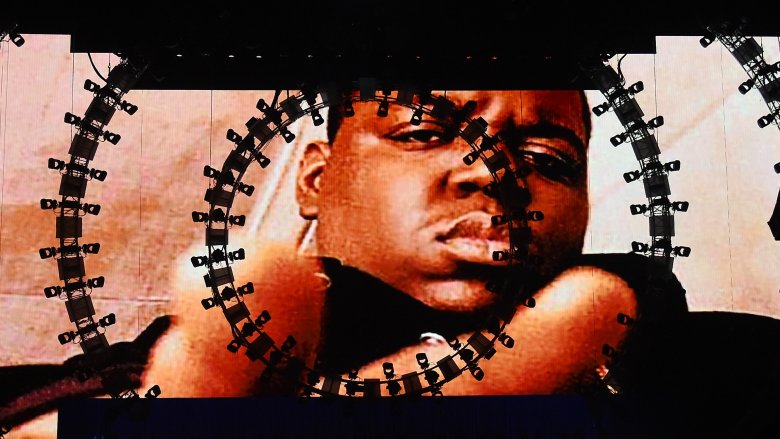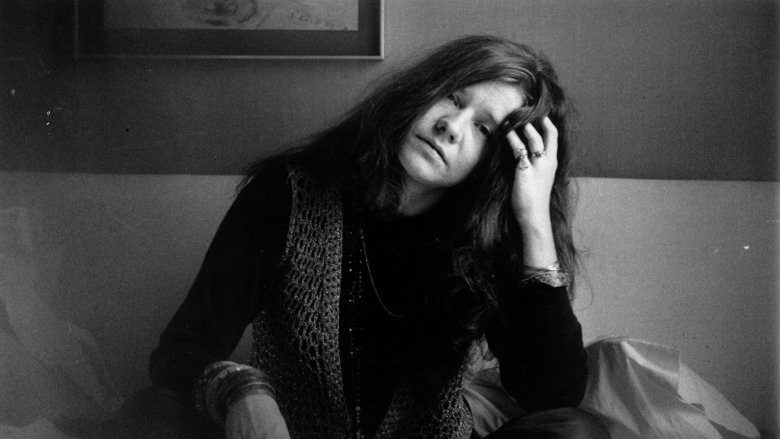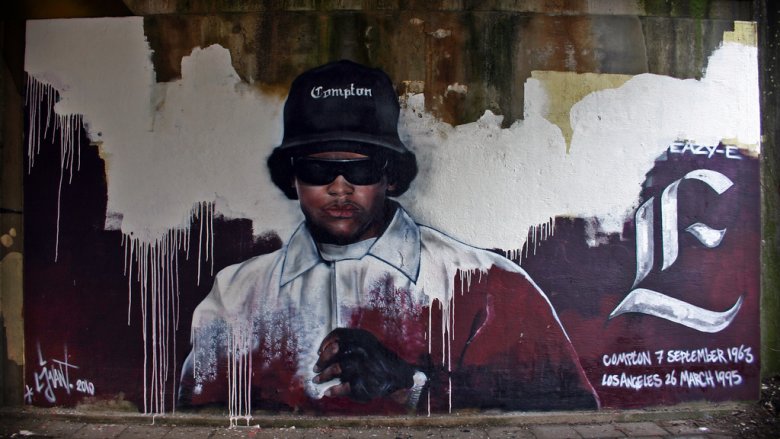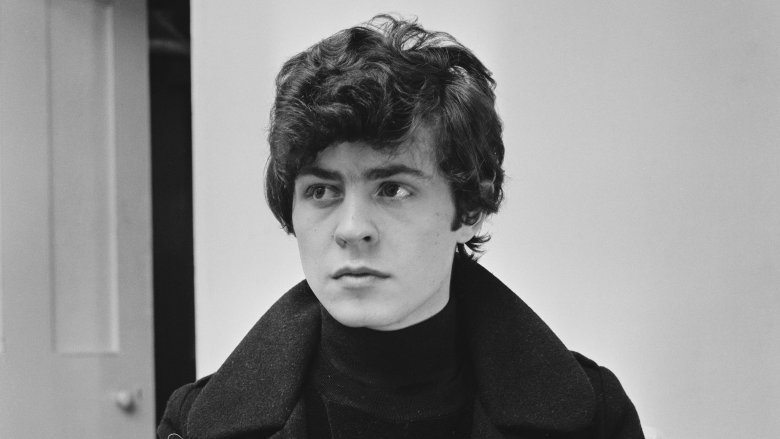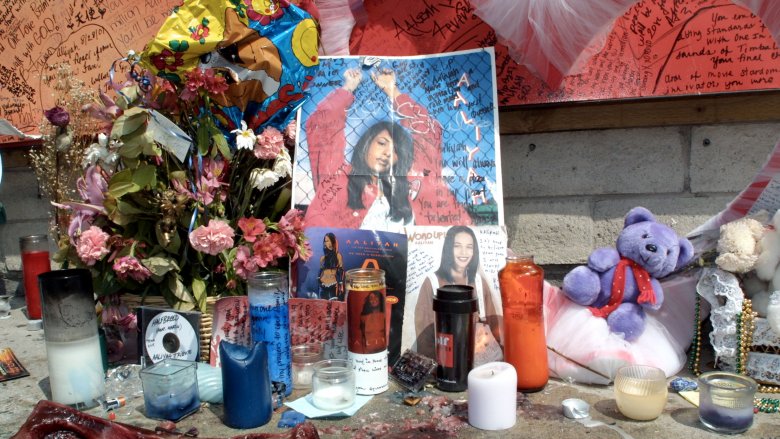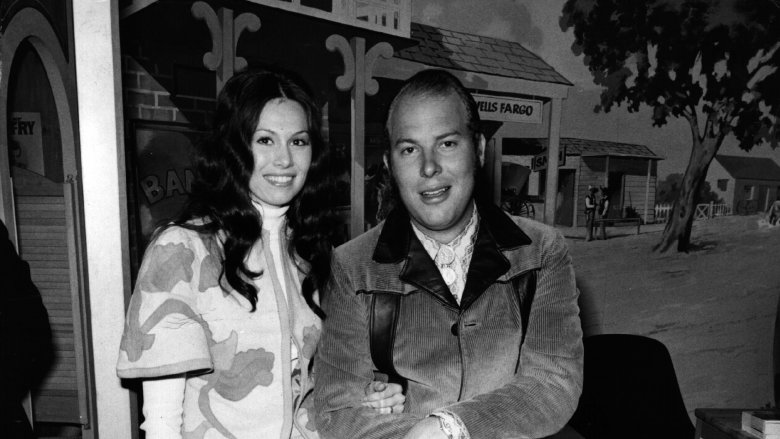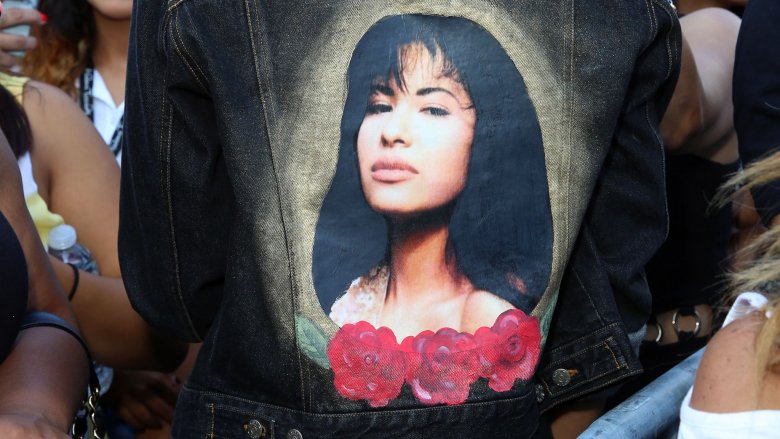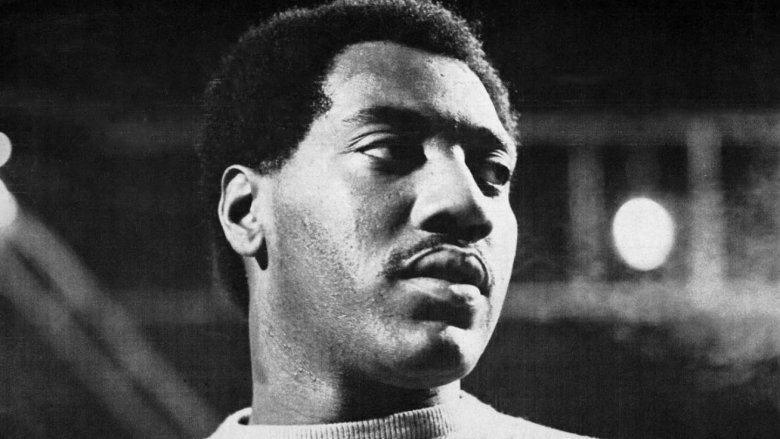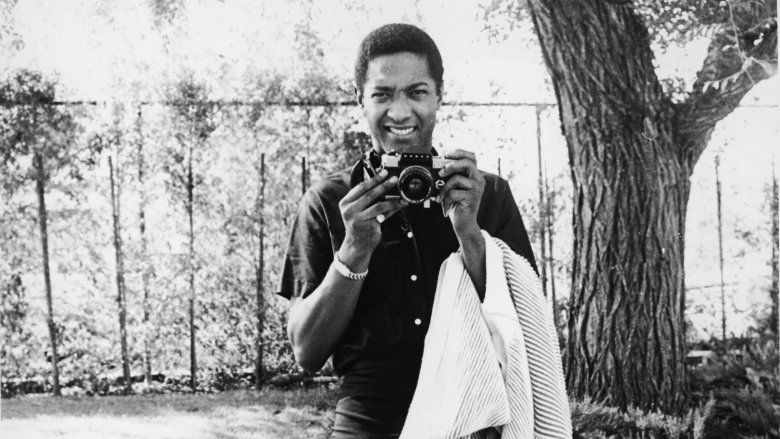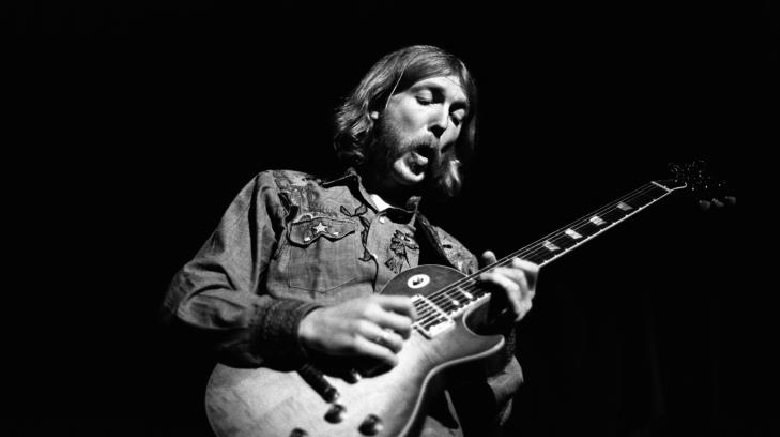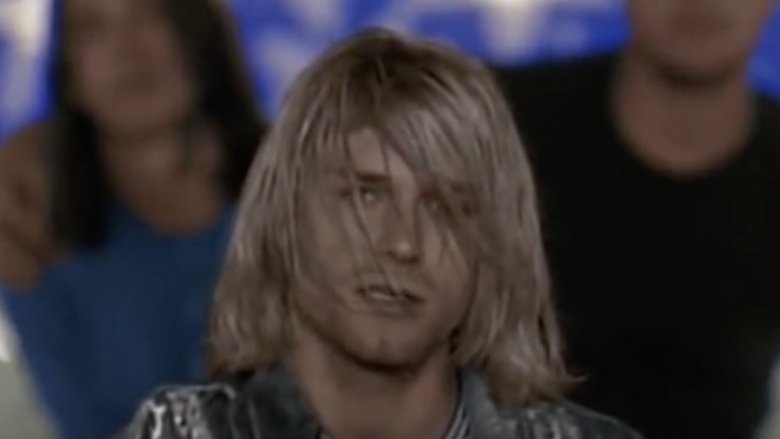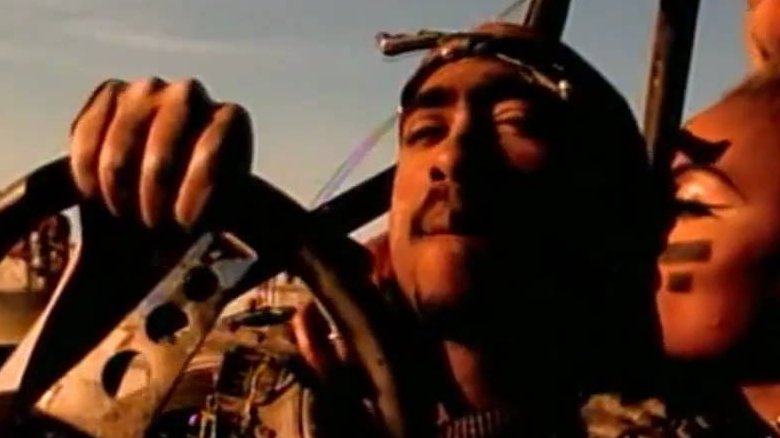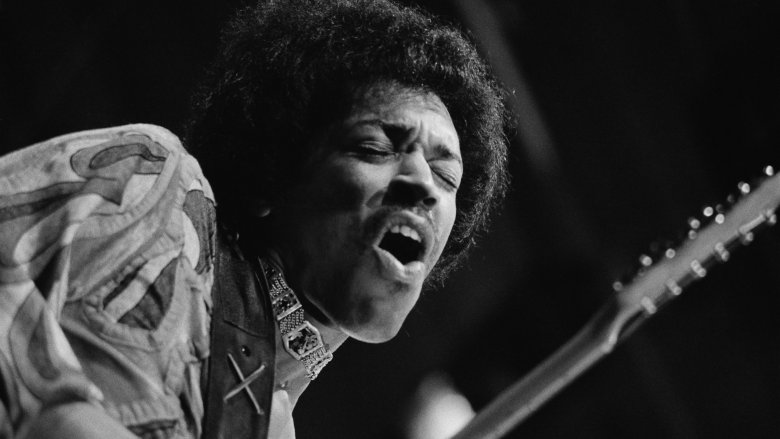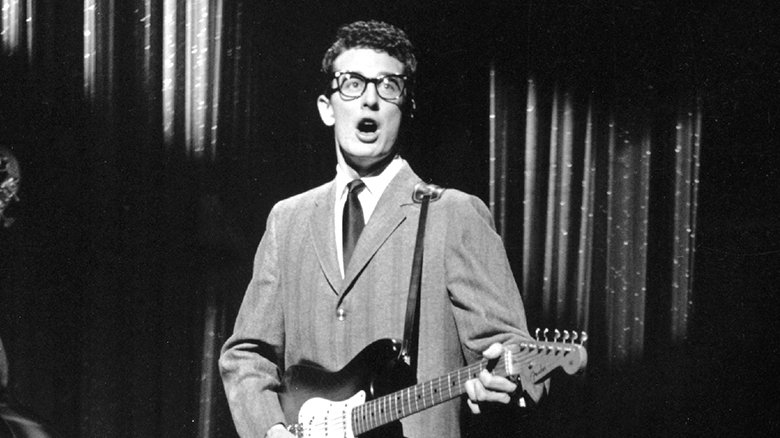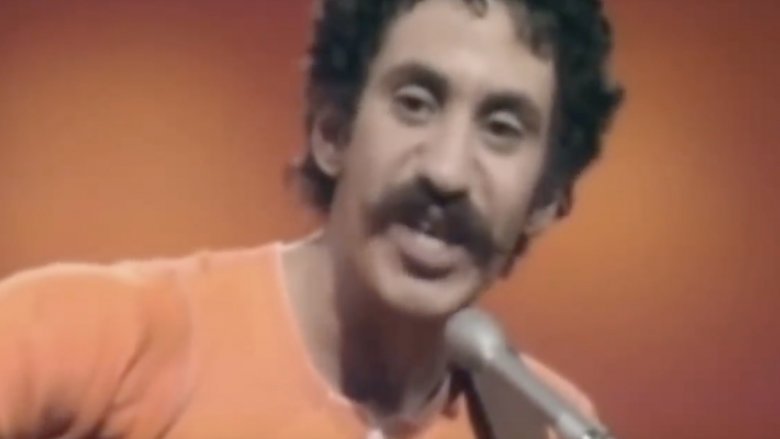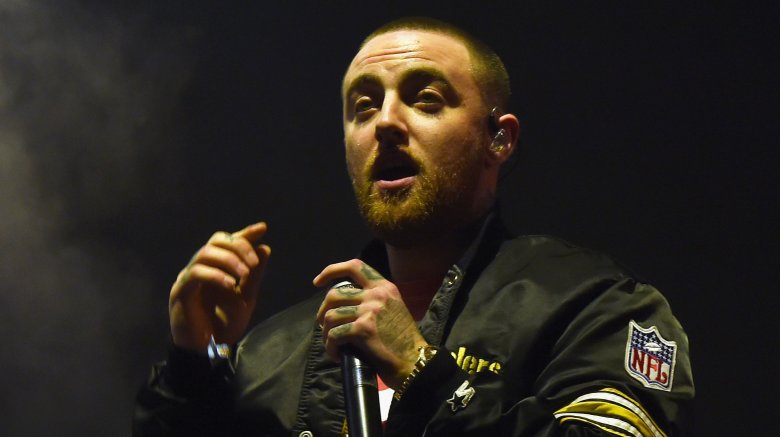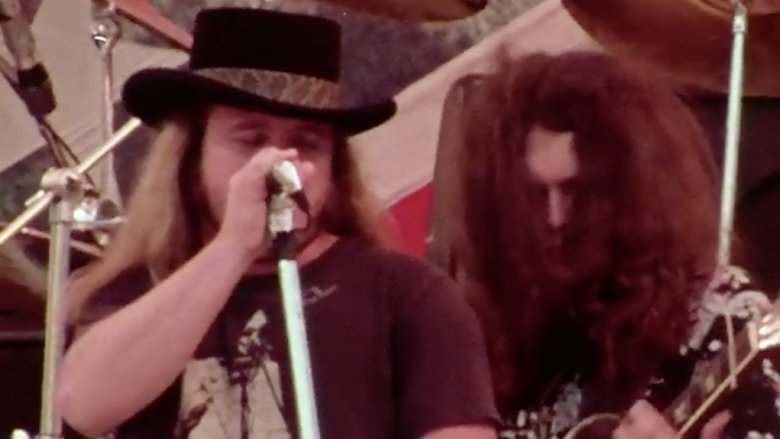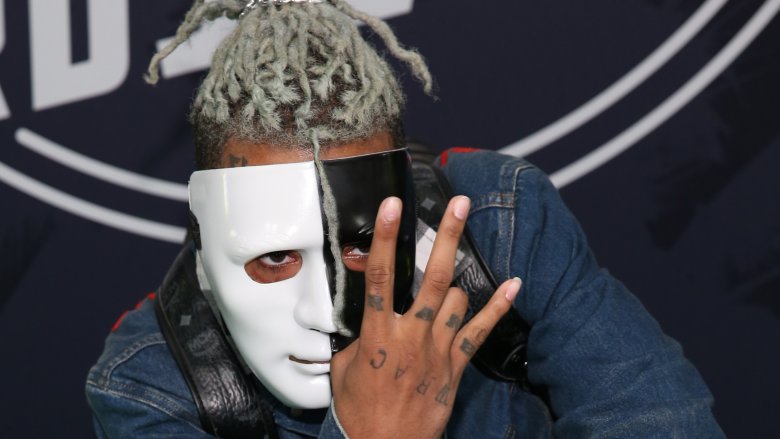Musicians Who Died Right At The Peak Of Their Fame
Let's face it: Musicians don't exactly have the most dangerous jobs on the planet. They're certainly not comparable to, say, lumberjacks or soldiers or those people who live on oil rigs for some reason. In fact, usually, the most dangerous day-to-day things a musician might encounter are high stages, late nights, and grouchy sound techs.
Despite their relatively non-hostile workplaces, however, the deaths of musicians are often highly publicized and deeply mourned among the wider cultural community. These deaths don't usually come from mid-gig accidents or health and safety disasters, but from problems extending beyond the stage. Drug overdoses, plane crashes, and shootings have been counted among the disasters that have taken some of the world's finest musicians away from us far, far too soon. It may not be the riskiest job out there, but there can be little doubt that there is something about musicians that seems to invite tragedy.
The mystery of Biggie Smalls
Biggie Smalls — that's the Notorious B.I.G. to you — was born Christopher Wallace in New York in the early '70s. He attended the George Westinghouse Career and Technical Education High School, the same establishment that gave the world DMX, Jay-Z, and Busta Rhymes. He dropped out at the age of 17. After a small stint in jail for dealing cocaine in North Carolina, Smalls released a demo tape which was picked up by The Source magazine in 1992. Before the year's end, Smalls had been signed to Sean Combs' label, Bad Boy Records. Over the course of his career, he released two critically acclaimed studio albums, worked with icons such as R. Kelly and Michael Jackson, and developed a vicious rivalry with Tupac Shakur.
In 1997, however, after leaving a party in Los Angeles, Smalls was murdered by an unidentified gunman who had pulled up beside his SUV at a red light. Smalls' death marked the end of the East Coast/West Coast feud which had enveloped the hip-hop world. To this day, the mysterious nature of his murder has inspired endless speculation and countless conspiracy theories.
Janis Joplin becomes a victim of heroin
Janis Joplin was a titan of psychedelic rock and one of the true icons of the 1960s. By the time of her death in 1970 she was, according to Rolling Stone, one of the world's foremost female singers and musicians. She had found fame at the 1967 Monterey Pop Festival, where she fronted the band Big Brother, with whom she continued down the road to stardom over the next two years thanks in part to the patronage of Bob Dylan's manager, Albert Grossman.
By 1969, she had become far more well-known than Big Brother itself and left to form the Kozmic Blues Band. Her success grew further, making repeated appearances on television and touring pretty much without end. By 1970, she was preparing to release her latest album, Pearl, which she had recorded with the Full Tilt Boogie Band. Her career and her life, however, came to a swift and tragic end. On October 4, 1970, she was found dead in her Hollywood hotel room. She was 27 years old. After a short investigation, her death was ruled as resulting from an accidental heroin overdose. Pearl, which was released posthumously, ended up going quadruple platinum through the years.
N.W.A.'s figurehead succumbs to AIDS
Of the various members behind N.W.A., Eazy-E brought one thing to the group the others could not: authenticity. Whereas Ice Cube went to college and Dr. Dre was once in an electro-funk band called World Class Wreckin' Cru, Eazy was the member who, according to Will.i.am, "never seemed like he was playing a role." He personified the ideal of the gangster-turned-rapper and can be counted as one of the few figures who truly set the scene for the genre of gangsta rap.
Eazy-E began Ruthless Records with money he had flipped from dealing drugs, and helped front N.W.A. as they rose to fame (and infamy) on the L.A. rap scene. Just as his contribution to N.W.A.'s image can't be understated, neither can his impact on the revolutionary ideals of black communities during the '90s. In 1995, however, at a time when he was reportedly worth $50 million, Eazy-E checked into a medical center in L.A. with what he believed to be asthma. He was instead diagnosed with AIDS and died a month later.
Glam rock's second wind is cut short
Marc Bolan (born Mark Feld) began his career playing skiffle music that was inspired by Lonnie Donegan, the world-renowned "King of Skiffle." By the mid-'70s, he would become one of music's most famous glam rockers. He formed his band, T. Rex, in the late '60s, and, by the beginning of the next decade, had begun to perfect the rockier, psychedelic sound for which they'd become so well-known. Over the course of the '70s, T. Rex became some of Britain's most prolific glam rockers, releasing well over half a dozen chart hits and selling out gigs across the country.
After a brief career stumble and a foray into heavy drug use, Bolan came back to form in 1977 with the release of Dandy in the Underworld, a new tour, and a slot presenting an evening television show on ITV. In September 1977, however, Bolan's second wind was stopped in its tracks after he was killed in a car accident while coming from a night in a London club. His long-time friend and rival, David Bowie, described Bolan as "the greatest little giant in the world."
Aaliyah is killed on a music video shoot
Aaliyah Dana Haughton, better known simply as Aaliyah, was an R&B singer from Brooklyn. She moved to Detroit with her family when she was 5, studied dance at the Detroit High School for the Fine and Performing Artists and by 14 had released her first album, produced by R. Kelly. Age Ain't Nothing but a Number sold over a million copies and put Aaliyah on the path to superstardom.
In 1996, she released her second album, One in a Million, which sold twice as many copies as her first. She soon branched out into modeling and acting and had just released her third album, Aaliyah, when she was killed in a plane crash in the Bahamas in 2001 while filming the video for her single "Rock the Boat." Eight other passengers, including crew members for the shoot and a close friend of Aaliyah's, were killed in the crash. Rolling Stone remembered her as "a driven, intelligent" and "unusually sweet and gentle spirit."
Country music's messiah is brought down by drink
Hank Williams was to country music what Hendrix was to rock music, what Bowie was to pop, what Joplin was to psychedelia. A legend within his genre, he can doubtless be counted among what PBS calls "the most powerfully iconic figures in American music." Born in Alabama and afflicted throughout his youth with a severe spinal condition, Williams found solace in music, learning to overcome both his physical issues and his shyness by writing and recording songs inspired by the blues musicians, gospel songs, and folk ballads of his home state. He found success quickly: Within six years he recorded almost 66 songs, 37 of which were smash hits.
That same success battered him, though, physically and mentally. The stresses of touring worsened his back issues and the pressures of his career pushed him toward alcoholism. He missed shows and was unable to maintain his big gigs. In 1952, he hired a bogus doctor who supplied him with highly dangerous prescription drugs. In December of that year he died en route to a couple small shows that had been arranged for New Year's Eve and New Year's Day.
Selena is killed by a fan
Selena Quintanilla-Pérez was, among other thing, a singer, songwriter, model, actress, designer, and speaker. She is one of the most prolific Hispanic musicians and celebrities ever, and is generally credited for bringing Latin music genres into the wider American mainstream. Born in Texas in 1971, Selena found fame in the world of Latin music in 1989 with the release of her self-titled debut album. Her second LP, Entre a Mi Mundo, was No. 1 on the Billboard Mexican Albums chart for eight consecutive months. All the while, Selena (who had barely left her teens) became a renowned community activist and civic personality.
In 1995, as the 23-year-old Selena seemed set to take the world by storm with the release of her first English-language album, she was shot dead by Yolanda Saldívar, the head of her own fan club, who had recently been fired for embezzling funds from the club. Within two years of her death, The New York Times was comparing her to Marilyn Monroe and Elvis, and a 2017 Hollywood Walk of Fame ceremony in her name drew the largest-ever crowd for those events. Her impact on pop music and contemporary fashion is still felt today.
Otis Redding's revolution ends too soon
Otis Redding wasn't merely a successful musician and a beloved artist — he was also a revolutionary. Born in Georgia in 1941, he grew up in a world that was white-dominated, to say the least. Even during the '60s, for a black musician to utilize his physicality and sexuality during performances as Redding did was, to many, nothing short of sacrilege. His courage, however, yielded great reward. By the time of his death, The New Yorker reported he was regarded by many as "the most charismatic and beloved soul singer of his generation."
He had toured in Britain, France, and Scandinavia as well as across America and had begun to record music that was growing ever more ambitious. This all came to a swift end, however, when Redding was killed in a plane crash in Wisconsin in 1967. The five teenage members of the Bar-Kays, the band backing him on his tour appearances at the time, were also killed. Redding was 26.
The murder of Sam Cooke
Described by AllMusic as "the most important soul singer in history," Sam Cooke was one of the first musicians to bridge the gap between white and black audiences. On top of this, he was also one of the first black musicians to found a record label (and a publishing company), and also became a stalwart figure in the civil rights movement. His career began in the 1930s, singing in the choir in his father's church; by the '50s he had released some of the decade's most successful hits. His music brought together the R&B, gospel, and pop genres into a sound that was utterly unique for the era.
His success grew during the '60s and peaked with a legendary show at the Harlem Square Club in Miami. But in 1964, Cooke was caught up in an altercation with the night manager of a motel. He was shot dead after — allegedly — attempting to attack her. The exact circumstances surrounding his death have since been questioned, and the truth of what happened that night still remains a mystery.
The Allmans lose a brother
Duane Allman, in giving his surname to the band he helped found, secured for himself one of the most famous names in rock and blues. He began playing music with his brothers in 1961 and saw some success (Duane's band The Escorts even once opened for the Beach Boys), but he didn't find real fame until the foundation of the Allman Brothers Band. By the '70s, they were one of music's most influential rock groups, achieving considerable critical acclaim with their album At Fillmore East.
In 1971, the whole band took, according to Rolling Stone, their "first real vacation in more than two years." Duane had been celebrating the birthday of the wife of Berry Oakley, the band's bassist, and was on his way home when his motorcycle flipped after swerving to avoid a truck. He died after three hours of surgery at a nearby hospital. Nearly 300 people attended his funeral.
The loss of Kurt Cobain
Nirvana combined elements of punk rock with hard rock to help popularize (along with other Seattle era grunge bands) a new kind of commercially viable but artistically vital music: alternative rock. The chief songwriter and artistic visionary behind the band that delivered '90s anthems like "Smells Like Teen Spirit," "In Bloom," and "All Apologies": Kurt Cobain, who really had a knack for writing lyrics that were both cryptic and voiced a deep cynicism for mainstream society. Alas, Cobain became saddled with a title he didn't want: "the voice of a generation."
Nirvana wasn't just a Cobain vehicle, it was a tight, heavy power trio thanks to bassist Krist Novoselic and drummer Dave Grohl. Nirvana released only three studio albums: Bleach (1989), Nevermind (1991), and In Utero (1993). Nevermind ultimately moved about 10 million copies, and in a symbolic "out with the old, in with the new," knocked Michael Jackson's Dangerous out of the #1 spot on Billboard's album chart. In Utero debuted at #1 on the same list in October 1993, and so when the group taped its episode of MTV Unplugged a month later, it was legitimately the biggest band in the world. Tragically, just a few months later, the severe depression that had long consumed Cobain claimed him. The 27-year-old rock star took his own life at his Seattle home in April 1994.
If you or anyone you know is having suicidal thoughts, please call the National Suicide Prevention Lifeline at 1-800-273-TALK (8255).
2Pac had just hit a milestone
Before he emerged as one of the most popular and era-defining rappers of the 1990s, Tupac Shakur, or 2Pac, as he was known in his musical career, bopped around on the fringes of the hip-hop world for years, serving as a roadie and occasional vocalist for Digital Underground. (Yes, the group who did "The Humpty Dance.") In 1991, 2Pac was ready to go solo, and he broke through in a big way with the stark and sad single "Brenda's Got a Baby." By 1993, he'd be a regular presence on the charts and MTV with one hit after another, some of them vividly painted pictures about the often difficult life he'd had as an African-American living in the inner city ("Keep Ya Head Up"), some of them boastful party jams ("I Get Around"). All of it expressed the same themes as songs by other artists associated with the "gangsta rap" movement, but none as poetically and viscerally as 2Pac. At the same time, the rapper enjoyed an acting career — he starred in Juice, Poetic Justice, and Above the Rim, among others.
When Shakur was gunned down in a drive-by shooting in Las Vegas in September 1996, the 25-year-old star had reached a career milestone just two months earlier: His double A-side single "How Do U Want It" / "California Love" hit #1 on the Billboard Hot 100.
An overdose was Jimi Hendrix's undoing
Virtually any list of the greatest rock guitarists of all time will rank Jimi Hendrix near or at the top. He's #1 on Rolling Stone's list, #4 on Guitar World's ranking, and the Rock and Roll Hall of Fame goes even further, calling Hendrix "the most gifted instrumentalist of all time." That praise and legend stems from a mere four years in the spotlight for Hendrix, an American who found his first taste of success in England in 1966, taking "Purple Haze," and "The Wind Cries Mary" into the top 10 with his band, the Jimi Hendrix Experience. The group recorded three albums in 1967 and 1968, all of them classics: Are You Experienced?, Axis: Bold as Love, and Electric Ladyland. Hendrix led the way on a fourth album with his new group, Band of Gypsies, but that was it. Why was Jimi Hendrix so great? He combined remarkable technical skills with dark blues flavor and riffs and a wild, drugged-out, psychedelic sensibility, provided the soundtrack for the acid-dropping counterculture of the hippie '60s. Scarcely a year after his landmark appearance playing "The Star-Spangled Banner" at the landmark festival of the time (and perhaps of all time), Woodstock, Hendrix was dead. A barbiturate overdose caused him to choke on his own vomit. He was just 27 years old.
Buddy Holly and the Day the Music Died
Buddy Holly's death was so shocking and tragic that it inspired Don McLean's lugubrious and lyrical "American Pie," a song that sort of equated the death of Holly in a February 1959 plane crash (along with Richie Valens and the Big Bopper) with the death of rock 'n' roll while still in its infancy, and which foretold the death of America itself. Don McLean did speak to at least one undeniable truth: Buddy Holly was absolutely huge, ranking near Elvis Presley in terms of popularity and influence and filling the void in the still burgeoning genre of rock 'n' roll in the late '50s when Presley dropped out for a while to join the military.
Holly was in the middle of a package rock 'n' roll tour, thrilling crowds in towns across the country with jangly, catchy, straight-forward hits like "That'll Be the Day," "Peggy Sue," and "Not Fade Away." In fact, he'd already scored seven top 40 hits at the time of his death in 1959. His career had lasted just over two years.
The road trip that ended too soon
Trained in classical guitar, Randy Rhoads applied the techniques he learned to his heavy metal music. His first major band was called Quiet Riot. When he was barely out of his teens, Rhoads played on the group's first two Japan-only releases in the late 1970s, Quiet Riot and Quiet Riot II. He left before the group scored its commercial breakthrough Metal Health, but that's okay, because he connected with the biggest metal idol of all: Ozzy Osbourne. After leaving Black Sabbath for a solo career, he hired Rhoades to be a guitarist in his band. Rhoads' hard-charging, vaguely menacing guitar work served as an ideal counterpoint to Osbourne's vocals, and he played on Osbourne's first two seminal albums: Blizzard of Ozz (1980) and Diary of a Madman (1981).
Rhoads hit the road with the self-proclaimed prince of darkness in 1982, and after a show in Knoxville, Tennessee, the band's bus headed to Orlando. When an air conditioner broke down, the bus stopped next to an airstrip occupied by a few planes. Bus driver Andrew Aycock was also a pilot (although his pilot's license was expired), and he thought it might be fun to sneak aboard a plane and take it for a spin. On his second trip, he took Rhoads and makeup artist Rachel Youngblood along. Then Aycock thought it would be hilarious to "buzz" the tour bus. Aycock got close on the first two attempts, but on the third try he clipped the bus and crashed the plane. While no one on the ground was hurt, all three people on board died, including Randy Rhoads, barely 25.
Another plane crash took Jim Croce
The folk craze, led by Joan Baez and Bob Dylan, hit big in the mid-'60s, which gave way to the singer-songwriter boom of the early 1970s. What set Jim Croce apart from other guitar-toting troubadours of the era was that he remained loyal to the classic folk sound, and he also liked to tell a story. Croce showed off his chops on a small 1966 release called Facets and 1969's Croce, a joint album with his wife, Ingrid. Croce wouldn't find a big audience until he signed with ABC Records (and grew that fantastic '70s 'stache) and scored two smash hit albums in 1972 and 1973: You Don't Mess Around with Jim and Life and Times. Included on those albums: Croce's signature musical tall tales and personal declarations, including what's probably his best known song, the #1 hit "Bad, Bad Leroy Brown."
Clearly, Croce was poised to be the voice of the '70s ... but it wasn't in the cards. Croce, 29, died in a plane crash in September 1973. His gut-wrenching single about the fleeting nature of life, "Time in a Bottle" topped the Hot 100 a few months after his death.
Mac Miller's tragic overdose
Mac Miller, a Pittsburgh rapper and musical prodigy, was only in the big time for less than a decade. In 2010, his mixtape K.I.D.S., released when Miller (born Malcolm McCormick) was merely 18. In 2011, his first studio effort Blue Slide Park topped the charts, a rare feat for an indie release. His status as an up-and-coming star was solidified further as he released more big albums and hit singles like "Self Care," "Loud," and "The Way," a collaboration with his girlfriend at the time, Ariana Grande.
By 2018, Mac Miller was hugely famous and at the top of his professional game, but he suffered in his personal life. In May 2018, he both broke up with Ariana Grande and ran his car into a utility pole (for which he was charged with a DUI). Miller struggled with depression and substance abuse, and addiction eventually got to him. He was found unresponsive by a friend at his California home in September 2018 and was pronounced dead. Authorities determined the cause of death to be an overdose of the painkiller Fentanyl mixed with cocaine.
Ronnie Van Zant and Steve Gaines of Lynyrd Skynyrd
The '70s were a fruitful period for new kinds of rock. Exciting styles emerged, everything from punk to heavy metal to Southern rock. Most definitive of the Southern rock style, which is a little bit country and a whole lot rock 'n' roll, was Lynyrd Skynyrd. The band is best known for the genre's unofficial theme song, "Sweet Home Alabama," and one of the most epic rock songs ever, "Free Bird." While other Southern rock bands like .38 Special and the Marshall Tucker Band would have some success, none of them were as crucial as Lynyrd Skynyrd, which started its run with a streak of five hit albums. The band's sound had gelled and their popularity was peaking when it released its fifth album, Street Survivors, on October 17, 1977.
Out on the road at the time Street Survivors hit stores, Skynyrd boarded a charter flight after a concert in Greenville, South Carolina, bound for the next gig in Baton Rouge, Louisiana. Somewhere over Mississippi, the plane ran out of fuel and pilots Walter McCreary and William Gray attempted an emergency landing. Tragically, they didn't make it, and the plane crashed. Lead singer Ronnie Von Zant died, as did guitarist Steve Gaines, backup singer Cassie Gaines, assistant road manager Dean Kilpatrick, and the pilots. The rest of the band and crew survived, although injured, and decided to split up for the time being.
XXXTentacion was shot to death
After releasing a slew of songs and albums on Soundcloud beginning in 2014, XXXTentacion dropped his first "official" single, "Look at Me," in 2016, and it hit the upper level of the Billboard pop chart. His first two full-length, non-Soundcloud albums captured a huge audience — 17 hit #2 on the album chart, and ? went to #1. And that's all before the guy turned 21.
For as much success as he had in music, the rapper born Jahseh Onfroy had a troubled and disturbing personal life. In 2016, he assaulted a romantic partner and threatened to cut out her tongue (reportedly because he caught her singing a song that wasn't one of his own songs), and a few months later, held a knife to the same woman's throat when he believed she was being unfaithful. When that same woman told XXX she was pregnant, he allegedly beat her, threatened to kill her, and locked her in an apartment. She escaped after two days of captivity. XXX faced numerous charges, but the case was never resolved. Then on June 18, 2018, XXXTentacion was fatally gunned down in Florida.
XXXTentacion's career never had a chance to fizzle out because it was still on the rise — he'd charted 30 songs already. He was so fresh on the scene that there was legitimate buzz he could've received a posthumous Best New Artist nomination at the 2019 Grammy Awards. (He was ultimately ruled ineligible because he'd released too much music to still be considered "new.")
Avicii's tragic suicide
DJs are the rock stars of the 2010s, holding court over huge crowds not by singing a note or strumming a guitar but creating a loud, musical experience through electronic musical manipulation. The most famous and popular of this new breed of musicians who made EDM a mainstream musical genre (and who also know exactly when to let the beat drop): Calvin Harris, Skrillex, and, perhaps biggest of all, Sweden's own Tim Bergling, aka Avicii.
While a highly sought after and highly paid live entertainer, Avicii made himself even more ubiquitous, translating and distilling his sound into a few hit singles, including "Levels," "You Make Me," "I Could Be the One," and especially "Wake Me Up," a #4 smash on the Billboard Hot 100 and destined to appear on every "best of the 2010s" compilation until the end of time.
While all his musical dreams came true, Avicii suffered from health problems offstage, including pancreatitis, which he attributed to excessive drinking. At age 24, he had his appendix and gall bladder removed, and soon after he stopped doing live gigs because they were too physically rigorous. By spring 2018, the 28-year-old DJ was gone. His death was reportedly a result of suicide.
If you or anyone you know is having suicidal thoughts, please call the National Suicide Prevention Lifeline at 1-800-273-TALK (8255).
Jeff Buckley drowned in a swimming accident
Jeff Buckley was in the public eye for such a short period of time and released such a small, exceptional body of work that it only adds to his legend. A songwriter and guitarist, Buckley boasted a voice that was ethereal, sensual, and soulful to the point of painful, and it propelled his one and only studio album, Grace, to critical acclaim and multiple "best of the year" lists. (Major publications like Entertainment Weekly, Melody Maker, Mojo, and NME placed Grace high on their various rankings.) Released in 1994, it didn't really hit big until 1995 thanks to standout singles like "Grace" and "Last Goodbye," and his definitive, devastating cover of Leonard Cohen's new standard "Hallelujah." In 1995, Rolling Stone and the MTV Video Music Awards singled out Buckley as one of the best new artists of the year.
The 30-year-old Buckley seemed on the cusp of a life as one of his generation's most important musicians, but it didn't come to pass because of the musician's mysterious death just two years after he received the music world's warm embrace. In May 1997, Buckley, in Memphis to work on his second album, went swimming in the Mississippi River, fell under the surface, and didn't come back up. His body was recovered a week later.
Amy Winehouse's career was cut short far too soon
When Amy Winehouse emerged in the mid-2000s, she offered something new by offering something old. With her beehive hairdos and vintage stage outfits, Winehouse looked like she had just time-traveled from the early 1960s. She also sounded amazing, dazzling crowds with her powerful, bluesy voice. The modern twist came from slick production by superstar knob-turner Mark Ronson as well as from Winehouse's often dark, very personal lyrics. For example, Winehouse sang from experience on her best-known song, the #9 hit "Rehab." Her one-time manager Nick Shymansky, claims he's the one who asked Winehouse to go to rehab, and, as the song goes, she said "no, no, no."
Nevertheless, "Rehab" made Winehouse an international star, and she cleaned up at the 2008 Grammys. Industry voters found her catchy, retro pop with more than a hint of darkness to be simply irresistible. The singer took home three out of the four biggest awards of the night: Record of the Year and Song of the Year (both for "Rehab") and Best New Artist. But Winehouse never kicked the substance abuse that led to her most famous song. On July 23, 2011, the 27-year-old singer died of alcohol poisoning.
